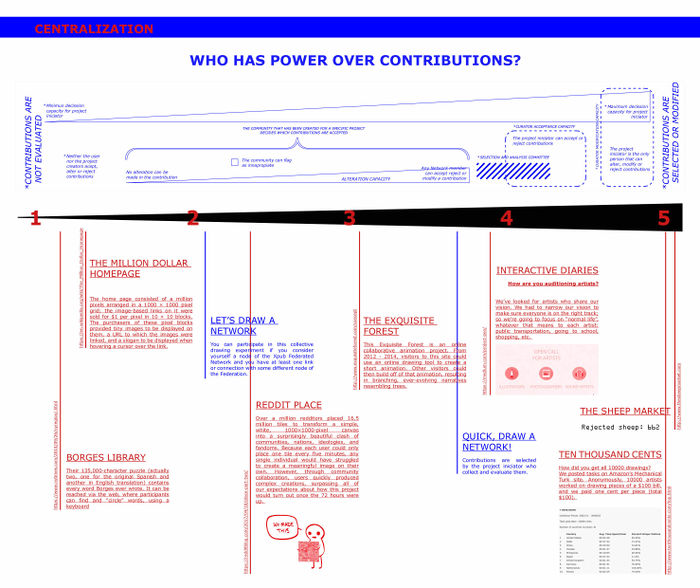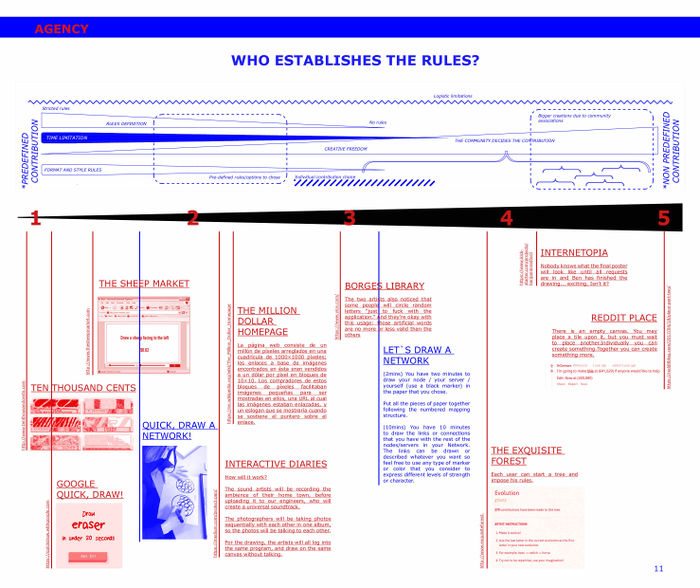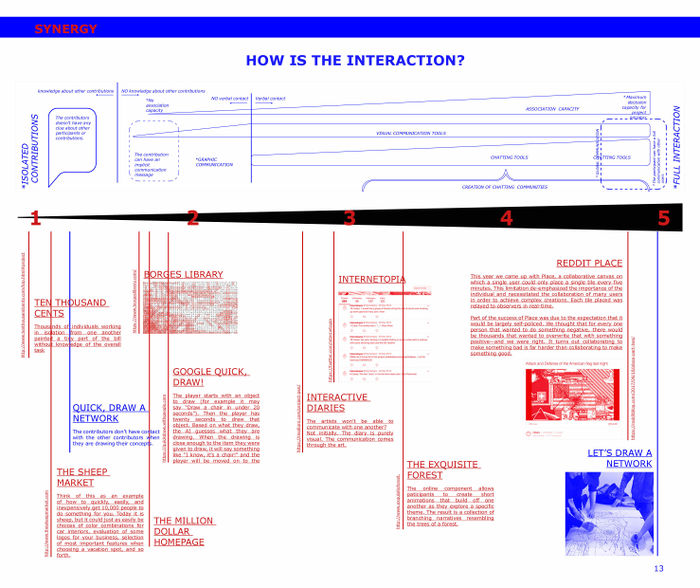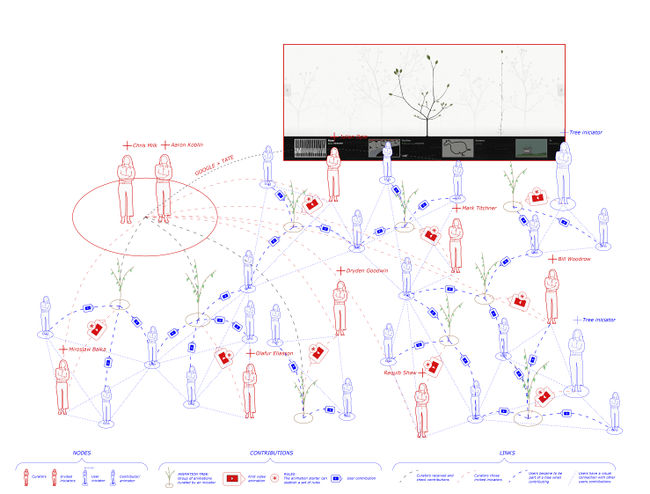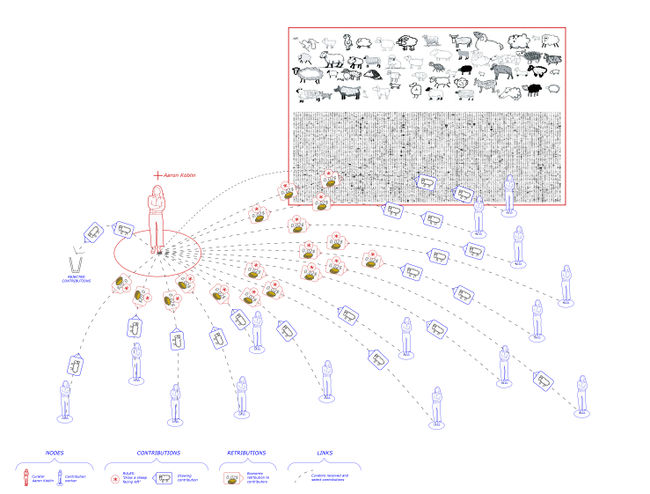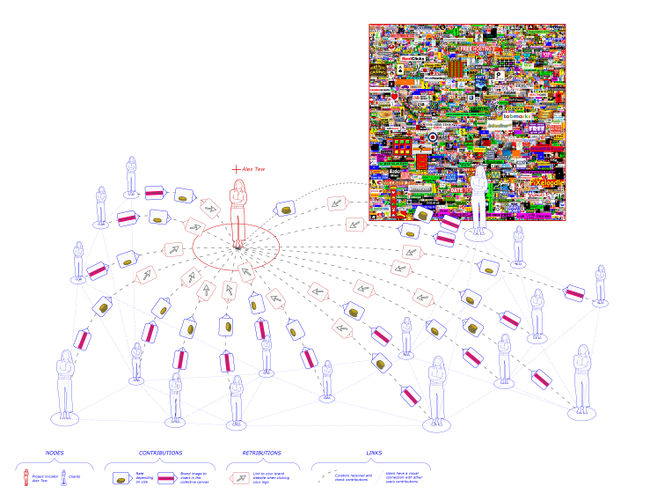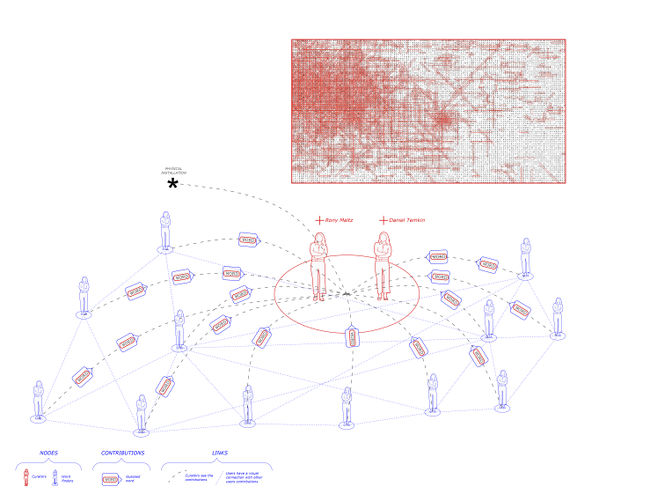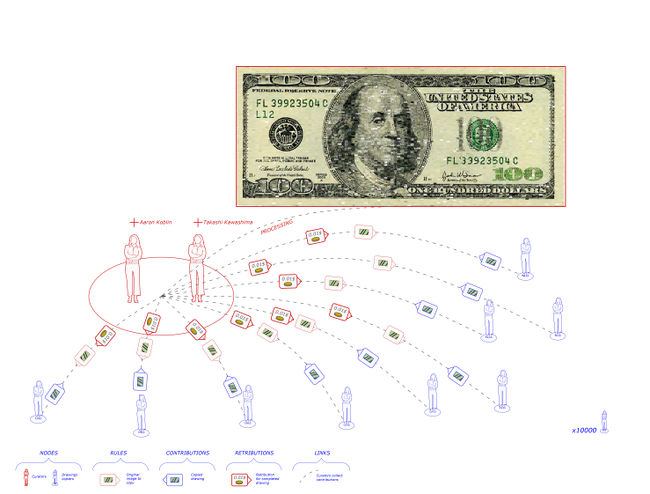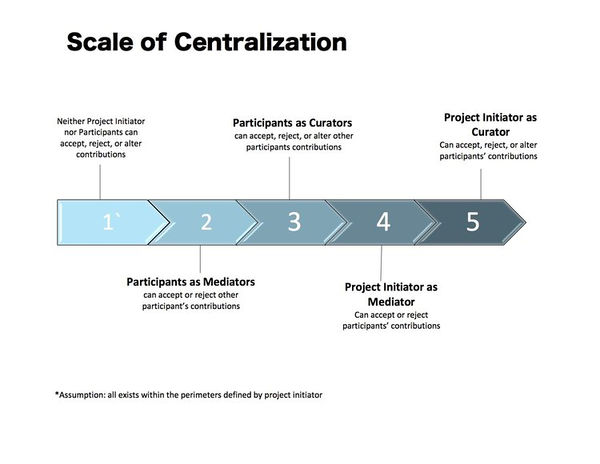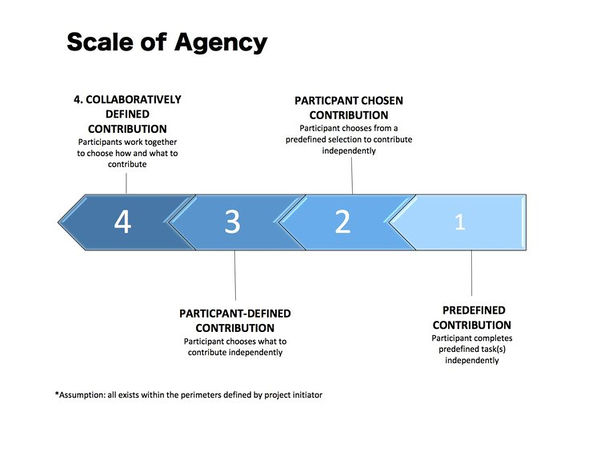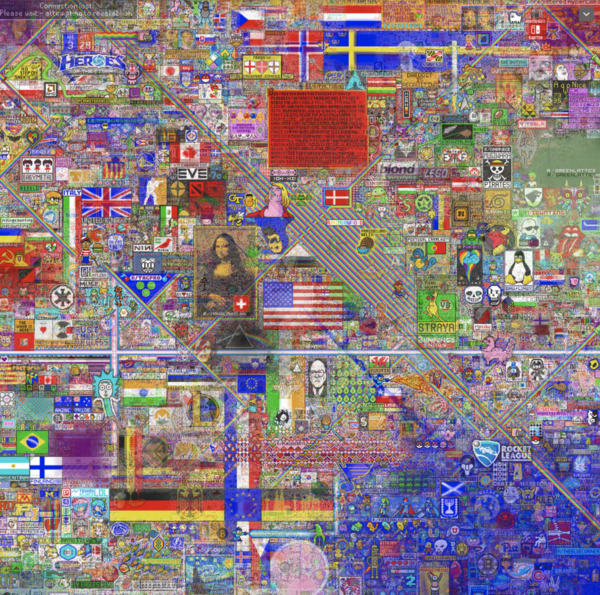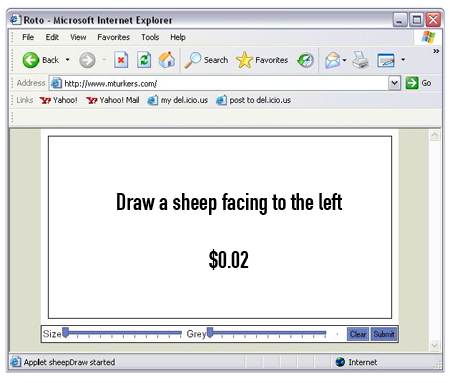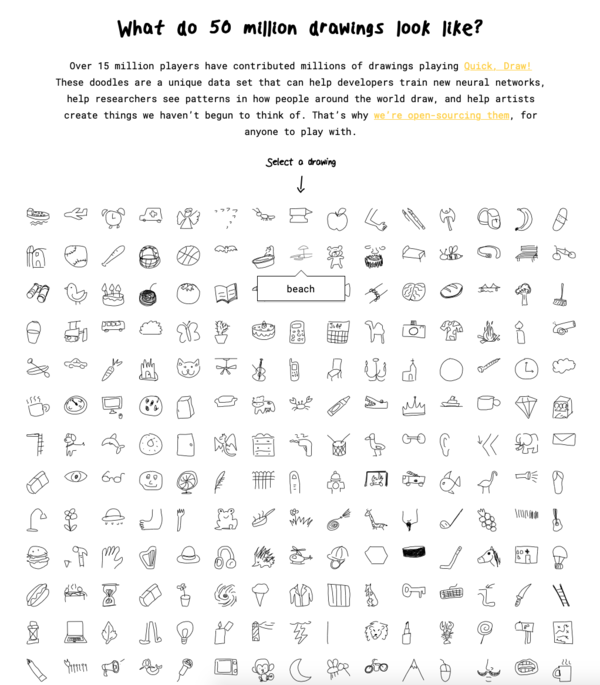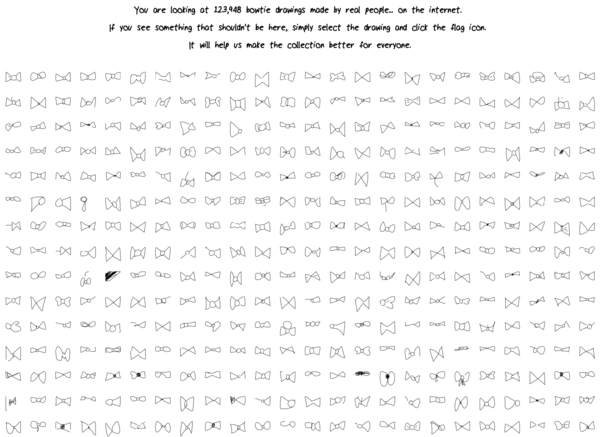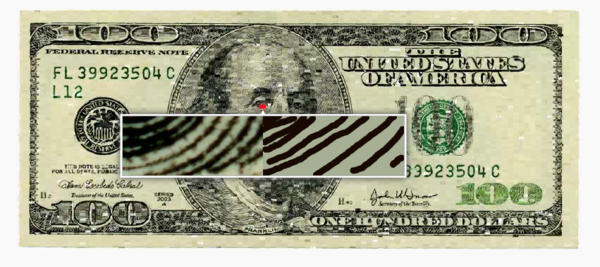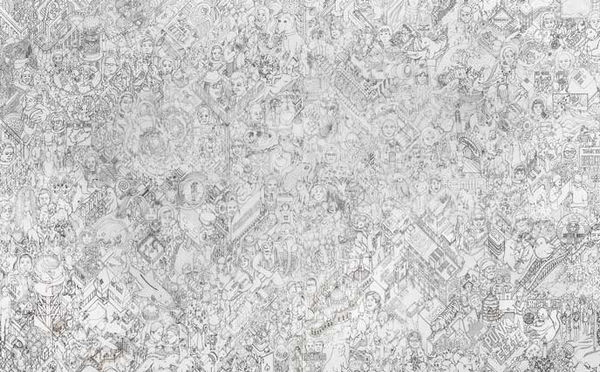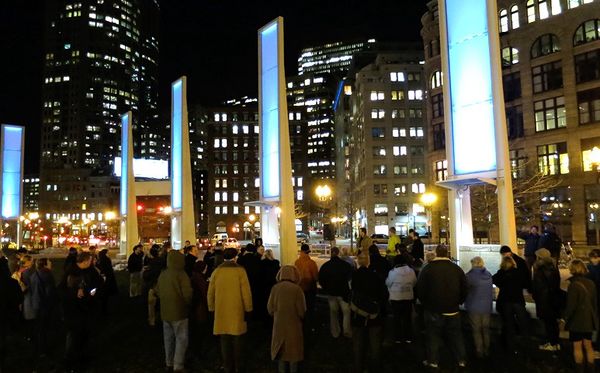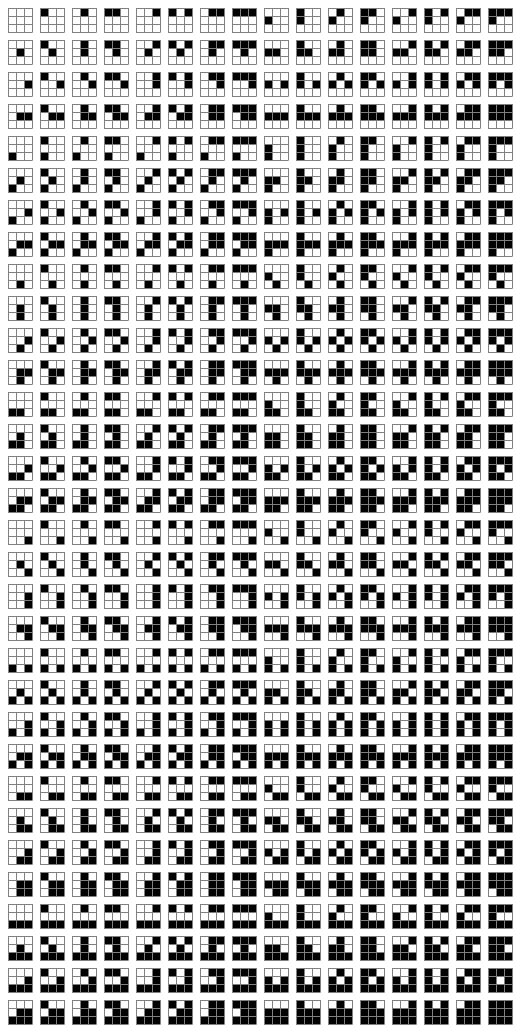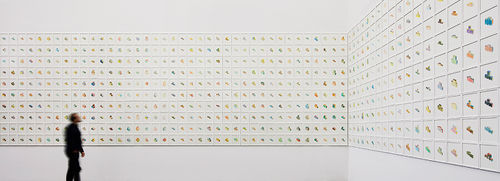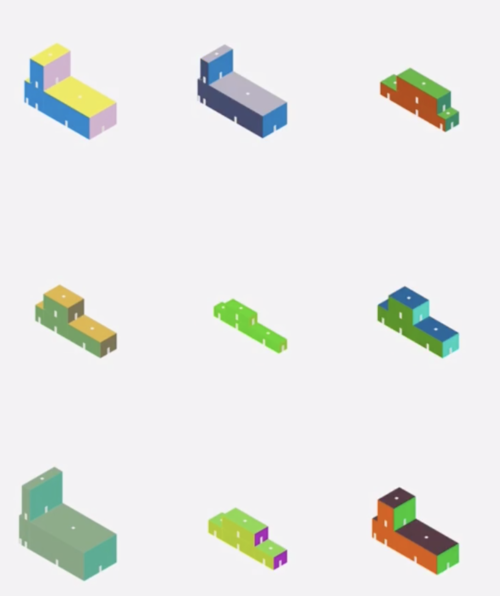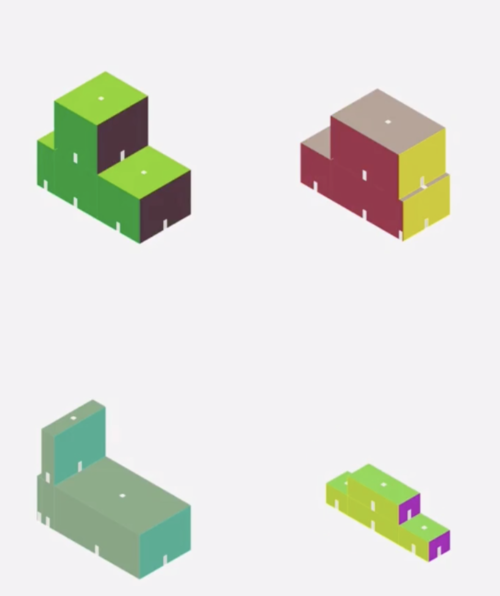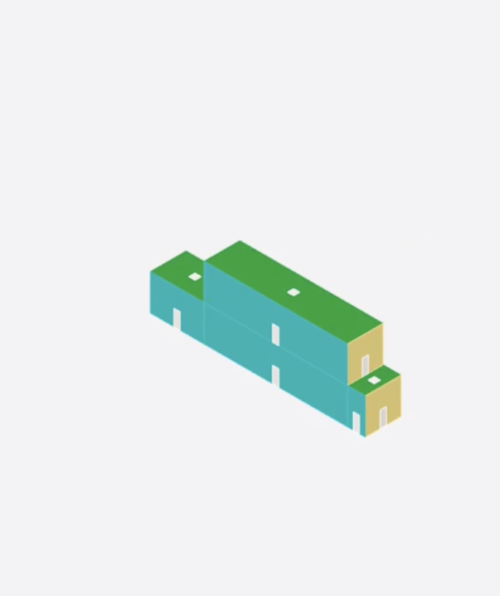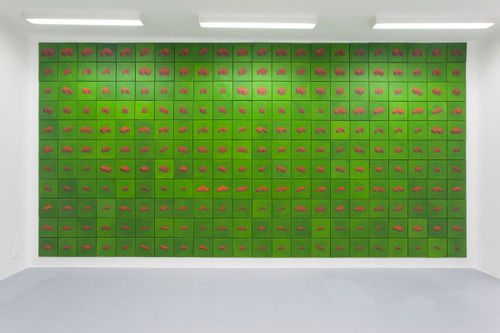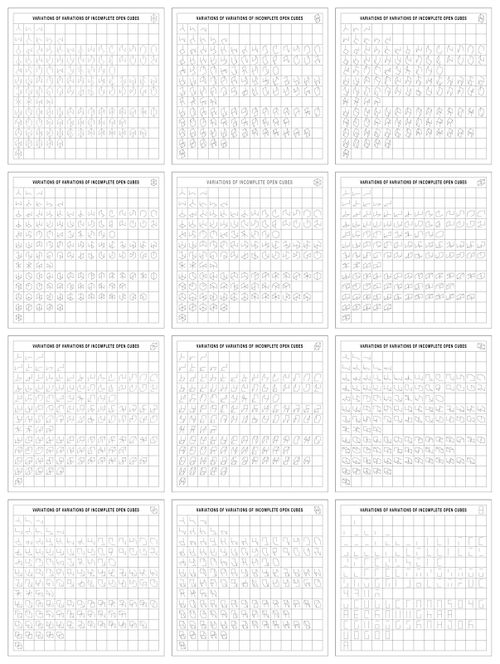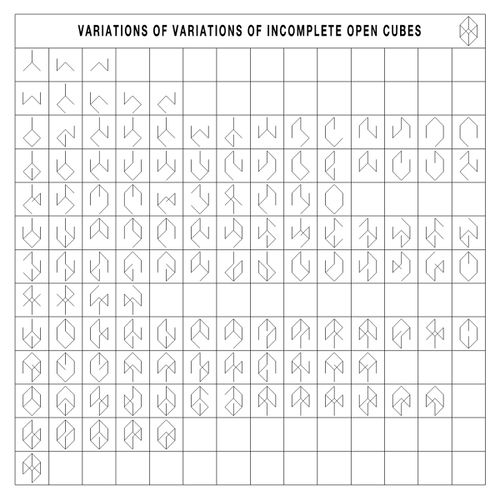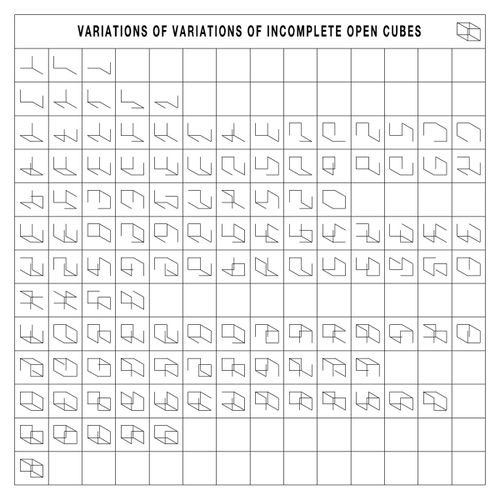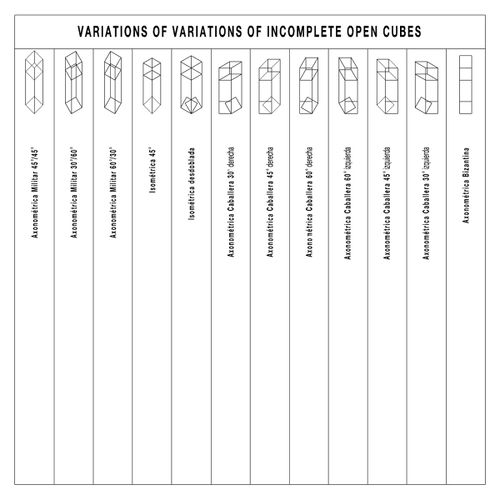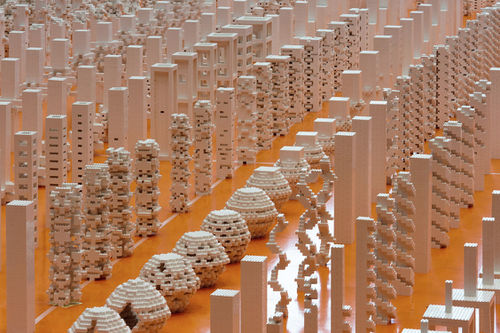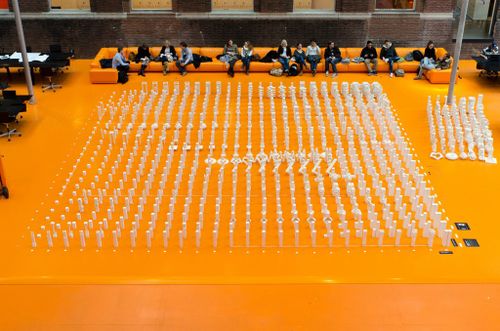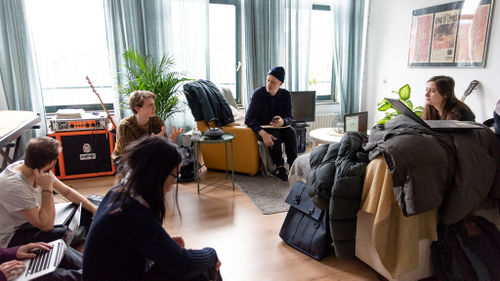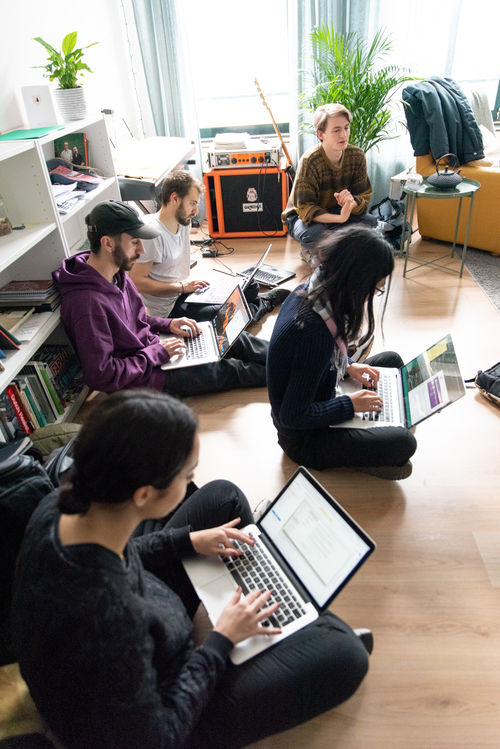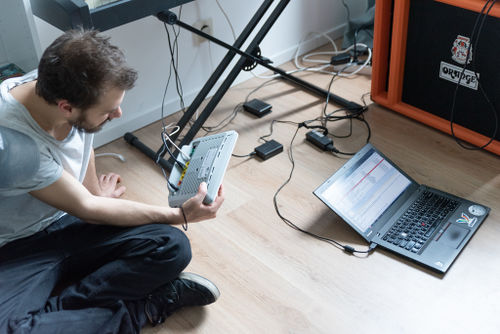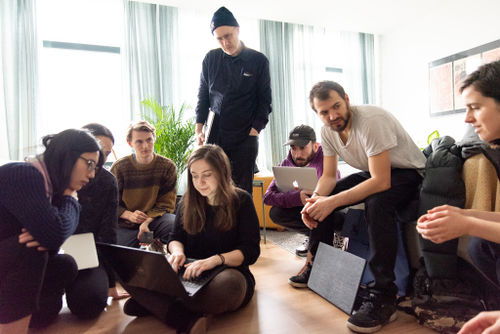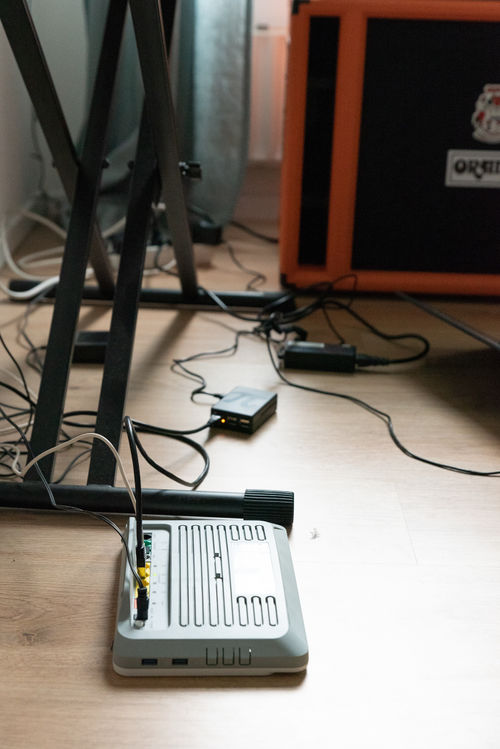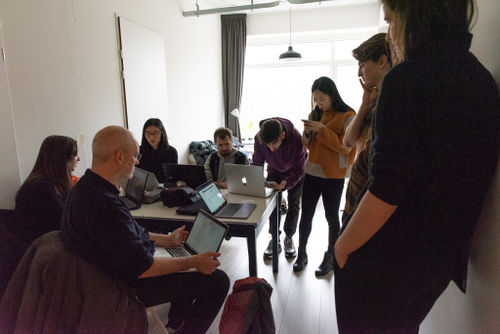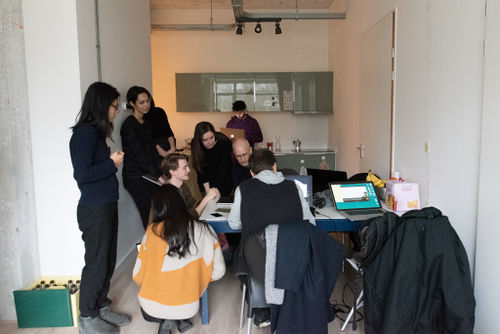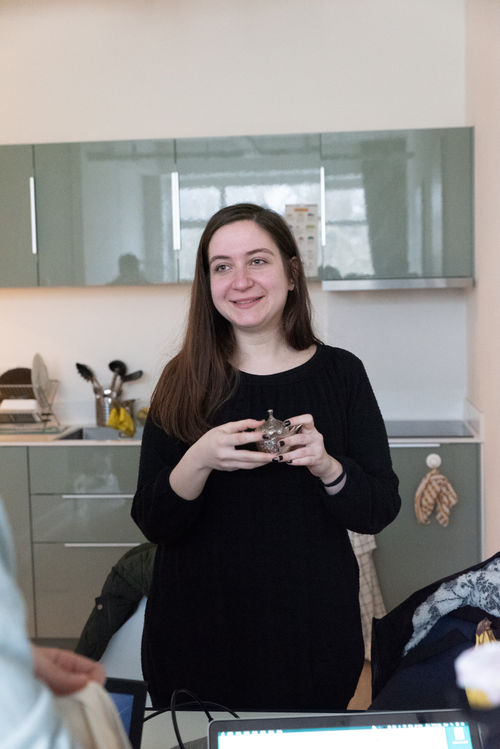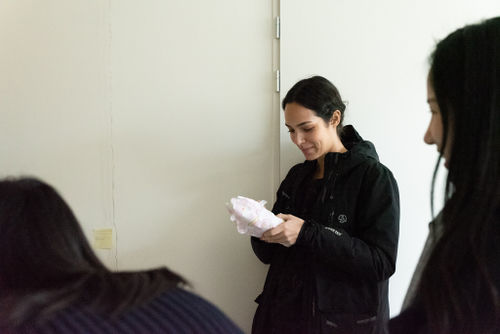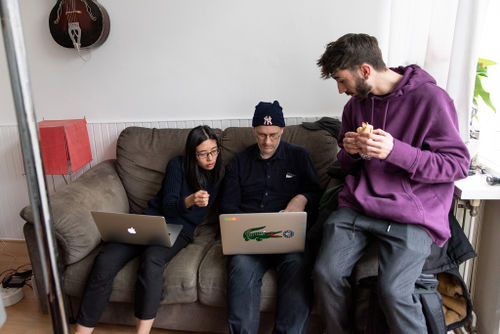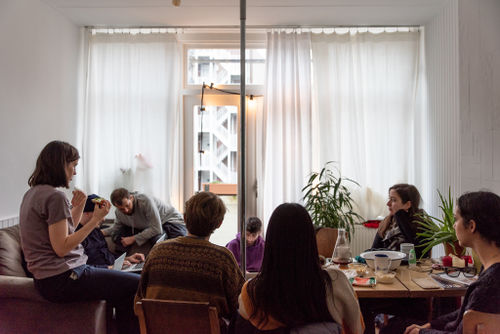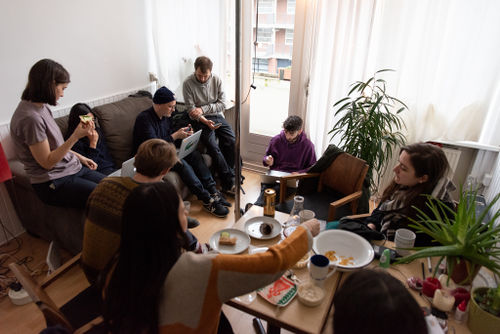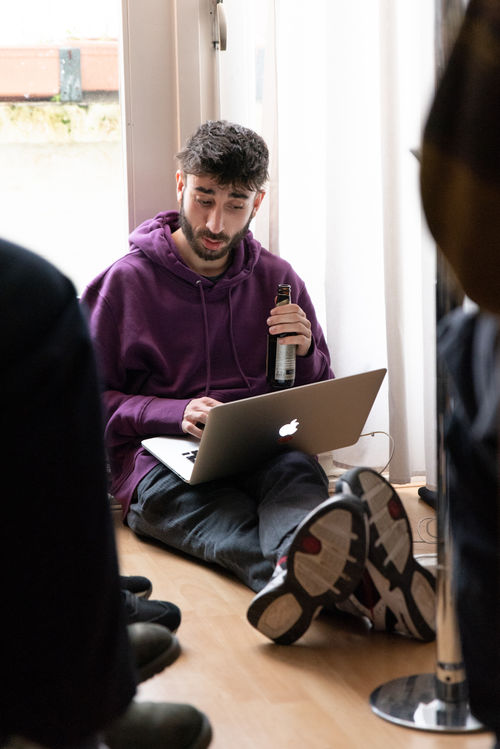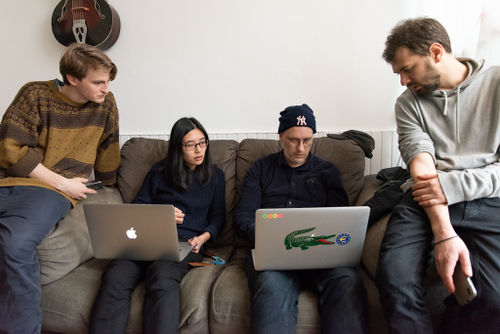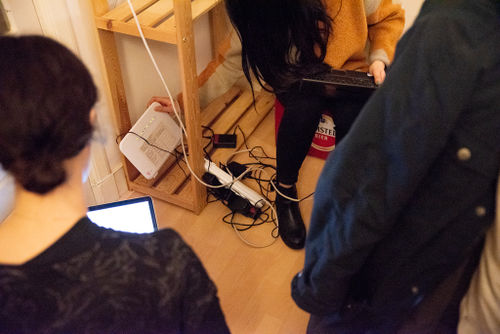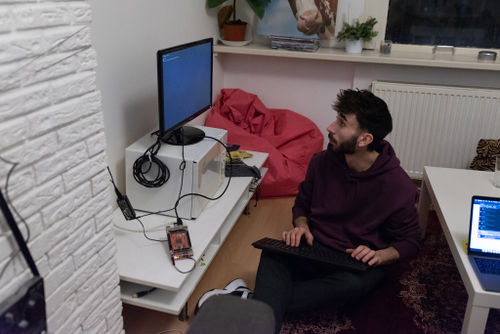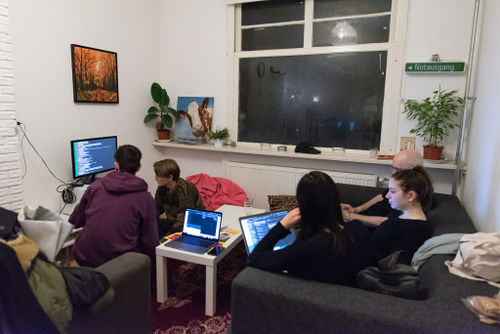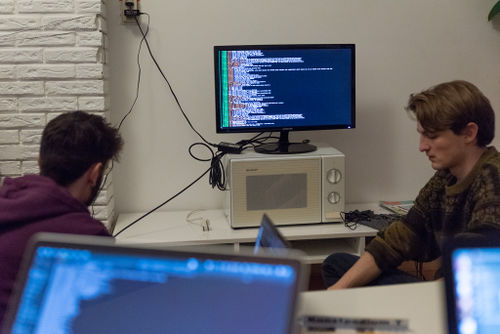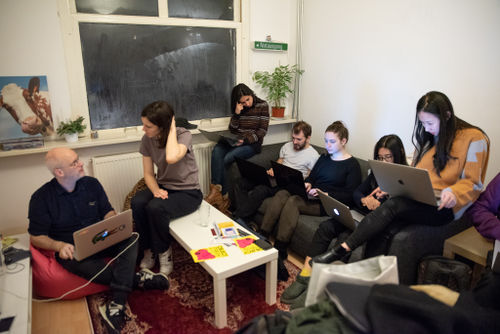User:Zpalomagar/Special Issue 8: Difference between revisions
Zpalomagar (talk | contribs) No edit summary |
Zpalomagar (talk | contribs) No edit summary |
||
| (60 intermediate revisions by the same user not shown) | |||
| Line 1: | Line 1: | ||
=Crowd-sourced Art Projects= | =Collaborative Networks= | ||
Collaborative initiatives invite users to work together pursuing a common goal. The participants of this projects, create a network that allows them to communicate and establish a series of links or connections that characterize the morphology of this collaborative network. The objective of this research is to analyze the different networks that are generated in order to create hibrid visual projects through crowd-sourced techniques. This common goal will only be achieved if a large amount of users/contributors create a set of links, rules and protocols and base their thought in acting locally and thinking globally. | |||
Each crowd-sourced project is characterized by a particular morphology to which we are going to approach, based on three reference levels. First, the scale of centralization determines who accepts, rejects or modifies the users’ contributions. This scale is directly related with the autonomy level that a participant reaches when producing their own contribution. Second, the level of agency determines the predefinition of the task that the user performs. This scale determines how strict are the rules imposed to the creator and therefore the user’s freedom to create his own contribution. The third element that will determine the nature and morphology of a collaborative networks is the level of synergy. This one, is connected with the interaction degree among users. So, the strength and typology and characteristics of the links that are created between different nodes of these networks. | |||
In order to have an active experience on collaborative and crowd-sourced initiatives, several drawing-based experiments are developed with the XPUB community. The levels of agency, synergy, and centralization are going to be modified trying to understand which are the contributors behavior consequences when transforming the nature of their network. Moreover, the visual result, will reflect this morphology modifications, allowing us to experiment different association and links through which to create a collaborative visual element. | |||
Crowd-sourced networks have been created for large and ambitious projects, especially in the last 10 years, when Internet communication is more than globalized. In this research, 7 web-based collaborative projects will be analyzed and mapped. The comparative analysis of these crowd-sourced mass projects allow us to have a comparative and global vision. Through projects such as The Exquisite Forest, Reddit Place or The Sheep Market, we will determine the network morphology created around it and how the graphic result shows a reflection of the structure and links between users behind it. | |||
When the visual collaborative objective is reached, it can be understood as a graphic representation of the complex network that exists behind them. The users / contributors / creators that are part of it leave their visual imprint that will become part of the essence of that crowd-sourded creation. Furthermore, communities and sub-communities that have been created to encourage more prominent elements will also have a literal translation into the global visualization. Can we understand collaborative projects as an X-ray of the creators networks that are formed behind them? | |||
==Collaborative Networks in Art productions== | |||
Crowdsourcing is creating something that’s greater than the sum of its parts.<sup>1</sup> This collaboration is been used to come up with new business ideas, solutions to social problems, funding new products , mapping environmental disasters, identifying potholes that need to be repaired and even getting someone to wait in line for your new iPhone.<sup>2</sup>This system enlist a multitude of humans to help solve a wide variety of problems.<sup>3</sup> The crowd-sourcing principle confirms that a collective creation can produce better (and cheaper) results than an individual.<sup>4</sup> | |||
Collaboration and community building are not only driving forces in everyday life. They also have emerged as important topics and practices in contemporary art, as Grant Kester illustrates in his publications.<sup>5</sup> Whether crowdsourced art grows into a prevalent method of expression, or, as one critic worries, becomes a form of “digital serfdom,” when millions of individuals from around the world contribute to a work, the work can be as diverse as the individual contributors.<sup>6</sup> Addressing communities and collaborative modes of production in different cultural and social contexts claims to be art.<sup>5</sup> Crowdsourced art is about inclusiveness, turning formerly passive audiences into active creators and empowering people who aren’t normally part of the art world.<sup>1</sup> | |||
The meta-narrative of globalization has brought into view many different manifestations and experiences that emphasise the “co.” How to deal with this diverse and complex phenomenon? This apparently inconsiderable prefix not only designates loopholes in canonical settings in art theory and practice, but also reveals a multitude of coexisting art notions and art practices.<sup>5</sup> Collaboration and community building in the arts lead to all kinds of results, situated between physical structures, social networks, and ephemeral events.<sup>5</sup> We can say that a crowdsourcing system enlists a crowd of users to explicitly collaborate to build a long-lasting artifact that is beneficial to the whole community.<sup>3</sup> | |||
Can collaboration over art reveal the inherent similarities between cultures and people?<sup>2</sup> People all over the world are dealing with the same things, just in different ways.How to recruit and retain users?<sup>2</sup> What contributions can users make? How to combine user contributions to solve the target problem? How to evaluate users and their contributions?<sup>3</sup> | |||
<small><small>1.http://www.artnews.com/2014/09/02/artists-and-crowdsourcing/ | |||
2.https://medium.com/smarter-cities/the-future-of-crowdsourcing-67ee31b88b5b | |||
3.https://cacm.acm.org/magazines/2011/4/106563-crowdsourcing-systems-on-the-world-wide-web/fulltext | |||
4.http://digicult.it/digimag/issue-050/distributed-creativity-models-the-crowdsourcing/ | |||
5.http://foa-flux.net/wp-content/uploads/2017/06/annemarie-bucher-2014-co-art.pdf | |||
6.http://flavorwire.com/85891/crowdsourced-art-when-the-masses-play-nice</small></small> | |||
==Crowdsourcing and collaboration for visual purposes, new?== | |||
Collaborative art is not an entirely new concept but has become easier than ever with the advent of digital technology.1 Crowd-sourced art emerged in the late 1950s and presented a radical paradigm shift from the artist as creator and fully separate from the audience, with the output of his creation to be displayed in museums and galleries, to a form of art more integrated into the public space and with participation from citizens in its creation<sup>.1</sup> An offshoot of social practice, crowds-sourced art has roots in the communal idealism of the late 1950s and ’60s, when Fluxus artists such as Allan Kaprow started staging Happenings and other interactive performances with the public. Fluxus member Yoko Ono was (and still is) a major progenitor of collaborating with the crowd. While those works were participatory, they weren’t exactly crowd-sourced.<sup>2</sup> | |||
The visual arts in Western contexts seem to be an exceptional case even though medieval European artists worked in collectives such as the “Bauhütte” (masons‘ lodge) and guilds, without (claiming) any individual authorship.<sup>3</sup> Creating a social sphere through art became pivotal in Joseph Beuys‘s concept and practice of “social sculpture” (soziale Plastik). Beuys‘s work is a popular source of building a community through art and of regaining social and political power for the arts.<sup>3</sup> | |||
Net art emerged in the 1990s when artists found that the internet was a useful tool to promote their art uninhibited by political, social or cultural constraints.<sup>4</sup> Over the past decade, numerous such systems have appeared on the World-Wide Web. Prime examples include Wikipedia, Linux, Yahoo! Answers, Mechanical Turk-based systems, and much effort is being directed toward developing many more.<sup>5</sup> Even the word crowdsource, coined by Jeff Howe in Wired magazine in 2006, has techy origins.<sup>2</sup> | |||
<small><small>1.https://digit.hbs.org/submission/from-drawings-on-a-board-to-interactive-apps-crowdsourced-art/ | |||
2.http://www.artnews.com/2014/09/02/artists-and-crowdsourcing/ | |||
3.http://foa-flux.net/wp-content/uploads/2017/06/annemarie-bucher-2014-co-art.pdf | |||
4. https://www.tate.org.uk/art/art-terms/i/internet-art | |||
5.https://cacm.acm.org/magazines/2011/4/106563-crowdsourcing-systems-on-the-world-wide-web/fulltext</small></small> | |||
==Network morphology: Centralization, Agency, Synergy== | |||
When a collaborative visual project is created, it generates a complex network of users/creators/contributors who will become an active and fundamental part of it. All this complex interconnected world that is created has different morphologies depending on the specific characteristics of the network that is generated around it. In order to determine the qualities of this set of links it is important to attend to three fundamental aspects represented by the concepts of centralization, agency and synergy. | |||
First the centralization scale determines who is going to select or modify the contributions or which filters are they going to overtake. We understand that a collaborative network is more centralized the more manipulation are allowed. Second, the agency level determines which are the rules imposed to the users, this concept is directly related to the freedom that a certain user has when making his contribution. A collaborative network acquires its highest point in the agency scale when stricter rules are imposed. Finally, we will analyze the interaction and communication between users. The networks generated when starting a collaborative project, can be tremendously extensive and the level of interaction among the users that compose it can be very diversed. This level of communication will determine the nature of the links that will be created and therefore the position of a certain collaborative network on the synergy scale. | |||
[[File:centralizationscale.jpg||700px|frameless|center]] | |||
[[File:agencyscale.jpg||700px|frameless|center]] | |||
[[File:synergyscale.jpg||700px|frameless|center]] | |||
==Collaborative initiatives== | |||
[[File:exquisiteforest.jpg|thumbnail|650px|center|The Exquisite Forest]] | |||
[[File:sheepmarket.jpg|thumbnail|650px|center|The Sheep Market]] | |||
[[File:milliondollar.jpg|thumbnail|650px|center|The Million Dollar Homepage]] | |||
[[File:interactivediaries.jpg|thumbnail|650px|center|Interactive Diaries]] | |||
[[File:borgeslibrary.jpg|thumbnail|650px|center|Borges Library]] | |||
[[File:redditplace.jpg|thumbnail|650px|center|Reddit Place]] | |||
[[File:Ten Thousand Cents.jpg|thumbnail|650px|center|Ten Thousand Cents]] | |||
=Crowd-sourced Projects= | |||
==Crowdsourced projects as networks== | |||
[[File:SCALEOFCENTRALIZATION.jpg|thumbnail | centre | 600px | Scale of centralization crowd sourced art]] | |||
[[File:SCALEOFAGENCY.jpg|thumbnail | centre | 600px | Scale of agency crowd sourced art]] | |||
==Net Art References== | ==Net Art References== | ||
===Reddit - Pixel === | ===Reddit - Pixel === | ||
[[File:VARIATIONS15.png|| | |||
Number of Contributors: 1,000,000 | |||
Scale of Agency Score: 4; Participants work together to choose what and how to contribute | |||
Scale of Centralization Score: 3; Participants accept, reject, and alter contributions | |||
Duration of Contribution Collection: 72 hours | |||
"Individually you can create something. Together you can create something more," the creators of the project wrote. | |||
[[File:VARIATIONS15.png|thumbnail | centre | 600px | Collaborative pixel canvas]] | |||
===Interactive diaries === | |||
The objective is to merge different cultures in an artwork | |||
The internet is a powerful tool for interaction. Art too, has its role in bringing people together. But what happens when artists from all over the world, strangers to each other, are invited to work together, online, on one project? | |||
[https://www.facebook.com/interactive.diaries?fref=ts FACEBOOK] | |||
[[File:INTERACTIVEDIARIES01.jpg|thumbnail | centre | 600px | Collaborative drawing interactive diaries]] | |||
[[File:INTERACTIVEDIARIES02.png|thumbnail | centre | 600px | Collaborative drawing interactive diaries]] | |||
===The exquisite forest=== | |||
[http://www.exquisiteforest.com/forest THE EXQUISITE FOREST] | |||
===Twitter opera=== | |||
[https://twitter.com/youropera TWITTER] | |||
===Sheeps by Aaron Koblin=== | |||
He proposed Amazon workers to draw a sheep facing to the left and he paid them .02$ Then he combine all this drawings | |||
Number of Contributors: 7599 unique IP addresses | |||
Scale of Agency Score: 1; Participants contribution is pre-defined by project initiator | |||
Scale of Centralization Score: 4; Project Initiator can accept or reject participants contributions | |||
Duration of Contribution Collection: 40 days | |||
[[File:SHEEP01.jpg|thumbnail | centre | 600px | Sheep collection]] | |||
[[File:SHEEP02.jpg|thumbnail | centre | 600px | Sheep collection zoom]] | |||
[[File:SHEEP03.jpg|thumbnail | centre | 600px | Interface sheep input]] | |||
===Quickdraw Google=== | |||
This is a collaborative projects launched by google in which people have to draw an object before the machine is able to guess which it this object so a fast sketch. Then google collect all this data classified by objects. | |||
This is not a random initiative. Google is using the users in this game to initiate an ambitious machine learning process. | |||
The amount of users is crazy —> power of centralisation | |||
Number of Contributors: 15,000,000 | |||
Number of Contributions: 1,000,000,000 | |||
Scale of Agency Score: 2; Participants choose from a selection of pre-defined contribution options | |||
Scale of Centralization Score: 2; Participants have the ability to accept, reject (in this case reclass) the contributions of others | |||
[https://quickdraw.withgoogle.com/data QUICKDRAW INDEX] | |||
[[File:QUICKDRAW01.png|thumbnail | centre | 600px | Quickdraw drawing index]] | |||
[[File:QUICKDRAW02.png|thumbnail | centre | 600px | Example drawing dow tie collection]] | |||
===The Moon Arts Group's Moon Drawings=== | |||
[[File:MOON01.png|thumbnail | centre | 600px | Internetopia global drawing]] | |||
===Ten Thousand cents=== | |||
[[File:TENTHOUSAND.png|thumbnail | centre | 600px | Collaborative bill drawing]] | |||
===Internetropia - Benjamin Redford=== | |||
[[File:INTERNETROPIA01.jpg|thumbnail | centre | 600px | Internetopia global drawing]] | |||
[[File:INTERNETROPIA02.jpg|thumbnail | centre | 600px | Internetopia price per cube]] | |||
===The White Globe Tracking === | |||
http://www.whiteglovetracking.com | |||
===The Johnny Cash Project=== | |||
http://www.thejohnnycashproject.com/#/explore/TopRated/fa377741b23ca3cd5fdeed9287389cd93f93dc44 | |||
===One Million Masterpiece=== | |||
[http://www.millionmasterpiece.com/view ONE MILLION MASTERPIECE] | |||
The most interesting thing about this project is the community that is created behind the drawing itself. Each artist has a username and can rate, contact or connect other users in a public timeline so it is not just a visualisation of their work but a artistic network in which the drawing is just an excuse to establish a link. | |||
===Color Commons=== | |||
[[File:COLORCOMMONS.jpeg|thumbnail | centre | 600px | Urban mobile light control]] | |||
==Collabrative painting webs== | |||
https://awwapp.com/b/ucr0tysds/# | |||
https://aggie.io | |||
https://sketchboard.io | |||
https://drawpile.net | |||
==Experimental project== | ==Experimental project== | ||
[[File:YAYOIKUSAMA.jpeg|thumbnail | centre | 600px | Yahoo Kusama - The Obliteration Room]] | |||
[[File:BUBBLES01.png|thumbnail | centre | 600px | Bubbles collaborative initiative]] | |||
Open source project [https://github.com/whichlight/bubblegum-postcard HERE] | |||
==First steps references - variations-== | ==First steps references - variations-== | ||
| Line 44: | Line 212: | ||
=== Mindsharing - Lior Zoref === | === Mindsharing - Lior Zoref === | ||
===Crowdsourced Digital Art Projects: Centralization And Agency - Jana Fredricks=== | |||
https://amt-lab.org/blog/2018/7/crowdsourced-digital-art-projects-centralization-and-agency | |||
===Crowdsourced Art: When the Masses Play Nice - Paul Hiebert=== | |||
http://flavorwire.com/85891/crowdsourced-art-when-the-masses-play-nice | |||
==Randomize== | ==Randomize== | ||
| Line 70: | Line 244: | ||
20. We have a lot of rain in June.<br> | 20. We have a lot of rain in June.<br> | ||
=The annotated reader= | |||
=Infrastructour= | =Infrastructour= | ||
| Line 95: | Line 269: | ||
[[File:INFRASTRUCTOUR-20.jpg||500px|frameless|center]] | [[File:INFRASTRUCTOUR-20.jpg||500px|frameless|center]] | ||
==Videos== | |||
[[Category:WttF]] | [[Category:WttF]] | ||
Latest revision as of 14:38, 11 April 2019
Collaborative Networks
Collaborative initiatives invite users to work together pursuing a common goal. The participants of this projects, create a network that allows them to communicate and establish a series of links or connections that characterize the morphology of this collaborative network. The objective of this research is to analyze the different networks that are generated in order to create hibrid visual projects through crowd-sourced techniques. This common goal will only be achieved if a large amount of users/contributors create a set of links, rules and protocols and base their thought in acting locally and thinking globally.
Each crowd-sourced project is characterized by a particular morphology to which we are going to approach, based on three reference levels. First, the scale of centralization determines who accepts, rejects or modifies the users’ contributions. This scale is directly related with the autonomy level that a participant reaches when producing their own contribution. Second, the level of agency determines the predefinition of the task that the user performs. This scale determines how strict are the rules imposed to the creator and therefore the user’s freedom to create his own contribution. The third element that will determine the nature and morphology of a collaborative networks is the level of synergy. This one, is connected with the interaction degree among users. So, the strength and typology and characteristics of the links that are created between different nodes of these networks.
In order to have an active experience on collaborative and crowd-sourced initiatives, several drawing-based experiments are developed with the XPUB community. The levels of agency, synergy, and centralization are going to be modified trying to understand which are the contributors behavior consequences when transforming the nature of their network. Moreover, the visual result, will reflect this morphology modifications, allowing us to experiment different association and links through which to create a collaborative visual element.
Crowd-sourced networks have been created for large and ambitious projects, especially in the last 10 years, when Internet communication is more than globalized. In this research, 7 web-based collaborative projects will be analyzed and mapped. The comparative analysis of these crowd-sourced mass projects allow us to have a comparative and global vision. Through projects such as The Exquisite Forest, Reddit Place or The Sheep Market, we will determine the network morphology created around it and how the graphic result shows a reflection of the structure and links between users behind it.
When the visual collaborative objective is reached, it can be understood as a graphic representation of the complex network that exists behind them. The users / contributors / creators that are part of it leave their visual imprint that will become part of the essence of that crowd-sourded creation. Furthermore, communities and sub-communities that have been created to encourage more prominent elements will also have a literal translation into the global visualization. Can we understand collaborative projects as an X-ray of the creators networks that are formed behind them?
Collaborative Networks in Art productions
Crowdsourcing is creating something that’s greater than the sum of its parts.1 This collaboration is been used to come up with new business ideas, solutions to social problems, funding new products , mapping environmental disasters, identifying potholes that need to be repaired and even getting someone to wait in line for your new iPhone.2This system enlist a multitude of humans to help solve a wide variety of problems.3 The crowd-sourcing principle confirms that a collective creation can produce better (and cheaper) results than an individual.4
Collaboration and community building are not only driving forces in everyday life. They also have emerged as important topics and practices in contemporary art, as Grant Kester illustrates in his publications.5 Whether crowdsourced art grows into a prevalent method of expression, or, as one critic worries, becomes a form of “digital serfdom,” when millions of individuals from around the world contribute to a work, the work can be as diverse as the individual contributors.6 Addressing communities and collaborative modes of production in different cultural and social contexts claims to be art.5 Crowdsourced art is about inclusiveness, turning formerly passive audiences into active creators and empowering people who aren’t normally part of the art world.1
The meta-narrative of globalization has brought into view many different manifestations and experiences that emphasise the “co.” How to deal with this diverse and complex phenomenon? This apparently inconsiderable prefix not only designates loopholes in canonical settings in art theory and practice, but also reveals a multitude of coexisting art notions and art practices.5 Collaboration and community building in the arts lead to all kinds of results, situated between physical structures, social networks, and ephemeral events.5 We can say that a crowdsourcing system enlists a crowd of users to explicitly collaborate to build a long-lasting artifact that is beneficial to the whole community.3
Can collaboration over art reveal the inherent similarities between cultures and people?2 People all over the world are dealing with the same things, just in different ways.How to recruit and retain users?2 What contributions can users make? How to combine user contributions to solve the target problem? How to evaluate users and their contributions?3
1.http://www.artnews.com/2014/09/02/artists-and-crowdsourcing/ 2.https://medium.com/smarter-cities/the-future-of-crowdsourcing-67ee31b88b5b 3.https://cacm.acm.org/magazines/2011/4/106563-crowdsourcing-systems-on-the-world-wide-web/fulltext 4.http://digicult.it/digimag/issue-050/distributed-creativity-models-the-crowdsourcing/ 5.http://foa-flux.net/wp-content/uploads/2017/06/annemarie-bucher-2014-co-art.pdf 6.http://flavorwire.com/85891/crowdsourced-art-when-the-masses-play-nice
Crowdsourcing and collaboration for visual purposes, new?
Collaborative art is not an entirely new concept but has become easier than ever with the advent of digital technology.1 Crowd-sourced art emerged in the late 1950s and presented a radical paradigm shift from the artist as creator and fully separate from the audience, with the output of his creation to be displayed in museums and galleries, to a form of art more integrated into the public space and with participation from citizens in its creation.1 An offshoot of social practice, crowds-sourced art has roots in the communal idealism of the late 1950s and ’60s, when Fluxus artists such as Allan Kaprow started staging Happenings and other interactive performances with the public. Fluxus member Yoko Ono was (and still is) a major progenitor of collaborating with the crowd. While those works were participatory, they weren’t exactly crowd-sourced.2
The visual arts in Western contexts seem to be an exceptional case even though medieval European artists worked in collectives such as the “Bauhütte” (masons‘ lodge) and guilds, without (claiming) any individual authorship.3 Creating a social sphere through art became pivotal in Joseph Beuys‘s concept and practice of “social sculpture” (soziale Plastik). Beuys‘s work is a popular source of building a community through art and of regaining social and political power for the arts.3
Net art emerged in the 1990s when artists found that the internet was a useful tool to promote their art uninhibited by political, social or cultural constraints.4 Over the past decade, numerous such systems have appeared on the World-Wide Web. Prime examples include Wikipedia, Linux, Yahoo! Answers, Mechanical Turk-based systems, and much effort is being directed toward developing many more.5 Even the word crowdsource, coined by Jeff Howe in Wired magazine in 2006, has techy origins.2
1.https://digit.hbs.org/submission/from-drawings-on-a-board-to-interactive-apps-crowdsourced-art/ 2.http://www.artnews.com/2014/09/02/artists-and-crowdsourcing/ 3.http://foa-flux.net/wp-content/uploads/2017/06/annemarie-bucher-2014-co-art.pdf 4. https://www.tate.org.uk/art/art-terms/i/internet-art 5.https://cacm.acm.org/magazines/2011/4/106563-crowdsourcing-systems-on-the-world-wide-web/fulltext
Network morphology: Centralization, Agency, Synergy
When a collaborative visual project is created, it generates a complex network of users/creators/contributors who will become an active and fundamental part of it. All this complex interconnected world that is created has different morphologies depending on the specific characteristics of the network that is generated around it. In order to determine the qualities of this set of links it is important to attend to three fundamental aspects represented by the concepts of centralization, agency and synergy.
First the centralization scale determines who is going to select or modify the contributions or which filters are they going to overtake. We understand that a collaborative network is more centralized the more manipulation are allowed. Second, the agency level determines which are the rules imposed to the users, this concept is directly related to the freedom that a certain user has when making his contribution. A collaborative network acquires its highest point in the agency scale when stricter rules are imposed. Finally, we will analyze the interaction and communication between users. The networks generated when starting a collaborative project, can be tremendously extensive and the level of interaction among the users that compose it can be very diversed. This level of communication will determine the nature of the links that will be created and therefore the position of a certain collaborative network on the synergy scale.
Collaborative initiatives
Crowd-sourced Projects
Crowdsourced projects as networks
Net Art References
Reddit - Pixel
Number of Contributors: 1,000,000 Scale of Agency Score: 4; Participants work together to choose what and how to contribute Scale of Centralization Score: 3; Participants accept, reject, and alter contributions Duration of Contribution Collection: 72 hours
"Individually you can create something. Together you can create something more," the creators of the project wrote.
Interactive diaries
The objective is to merge different cultures in an artwork
The internet is a powerful tool for interaction. Art too, has its role in bringing people together. But what happens when artists from all over the world, strangers to each other, are invited to work together, online, on one project?
The exquisite forest
Twitter opera
Sheeps by Aaron Koblin
He proposed Amazon workers to draw a sheep facing to the left and he paid them .02$ Then he combine all this drawings
Number of Contributors: 7599 unique IP addresses Scale of Agency Score: 1; Participants contribution is pre-defined by project initiator Scale of Centralization Score: 4; Project Initiator can accept or reject participants contributions Duration of Contribution Collection: 40 days
Quickdraw Google
This is a collaborative projects launched by google in which people have to draw an object before the machine is able to guess which it this object so a fast sketch. Then google collect all this data classified by objects.
This is not a random initiative. Google is using the users in this game to initiate an ambitious machine learning process.
The amount of users is crazy —> power of centralisation
Number of Contributors: 15,000,000 Number of Contributions: 1,000,000,000 Scale of Agency Score: 2; Participants choose from a selection of pre-defined contribution options Scale of Centralization Score: 2; Participants have the ability to accept, reject (in this case reclass) the contributions of others
The Moon Arts Group's Moon Drawings
Ten Thousand cents
Internetropia - Benjamin Redford
The White Globe Tracking
http://www.whiteglovetracking.com
The Johnny Cash Project
http://www.thejohnnycashproject.com/#/explore/TopRated/fa377741b23ca3cd5fdeed9287389cd93f93dc44
One Million Masterpiece
The most interesting thing about this project is the community that is created behind the drawing itself. Each artist has a username and can rate, contact or connect other users in a public timeline so it is not just a visualisation of their work but a artistic network in which the drawing is just an excuse to establish a link.
Color Commons
Collabrative painting webs
https://awwapp.com/b/ucr0tysds/#
Experimental project
Open source project HERE
First steps references - variations-
3x3 combination
Mauricio Pezo and Sofia von Ellrichshausen
Variations of incomplete cubes - Gabriela Cardenas
The Why Factory Exhibition MVRDV
Photoshoot
Junya Ishigami
Readings
Mindsharing - Lior Zoref
Crowdsourced Digital Art Projects: Centralization And Agency - Jana Fredricks
https://amt-lab.org/blog/2018/7/crowdsourced-digital-art-projects-centralization-and-agency
Crowdsourced Art: When the Masses Play Nice - Paul Hiebert
http://flavorwire.com/85891/crowdsourced-art-when-the-masses-play-nice
Randomize
RANDOM SENTENCES
1. She did her best to help him.
2. Yeah, I think it's a good environment for learning English.
3. I'd rather be a bird than a fish.
4. Sometimes, all you need to do is completely make an ass of yourself and laugh it off to realise that life isn’t so bad after all.
5. This is the last random sentence I will be writing and I am going to stop mid-sent
.
6. She borrowed the book from him many years ago and hasn't yet returned it.
7. Lets all be unique together until we realise we are all the same.
8. There were white out conditions in the town; subsequently, the roads were impassable.
9. I love eating toasted cheese and tuna sandwiches.
10. He said he was not there yesterday; however, many people saw him there.
11. Italy is my favorite country; in fact, I plan to spend two weeks there next year.
12. The clock within this blog and the clock on my laptop are 1 hour different from each other.
13. It was getting dark, and we weren’t there yet.
14. Cats are good pets, for they are clean and are not noisy.
15. Abstraction is often one floor above you.
16. I would have gotten the promotion, but my attendance wasn’t good enough.
17. Wednesday is hump day, but has anyone asked the camel if he’s happy about it?
18. I hear that Nancy is very pretty.
19. If you like tuna and tomato sauce- try combining the two. It’s really not as bad as it sounds.
20. We have a lot of rain in June.

